Introduction
In every community or country, children play most important role as they are the heart of socioeconomic development. The general health, wellbeing, education and development of the children can be affected by oral health. In many countries, large numbers of children, parents and teachers have limited knowledge about the causes, occurrence and prevention of the most common oral diseases. Children spend considerable period of time in the school right through childhood and adolescence. This period has a special importance in their growing age as they are particularly receptive during this age which is more so when the message has been delivered from a school teacher. The school plays a pivotal role in the growth of young minds and also is an ideal place for learning new information.[1] In response to the World Health Organization (WHO) guidelines in the year 1978, many countries utilized school teachers as health education promoters for school children, o serve as alternate personnel in primary health care approach in combating preventable diseases. School-based dental education is internationally recognized and most effective because children are approached when their health habits are being formed. This might play an important role in increasing the knowledge of oral health and disease among school teachers. Several studies have proven success in utilization of school teachers as oral health educators in terms of improved oral health among school children.[2]-[7] Despite the willingness to impart general oral health education, they seem to lack formal basic training in oral health matters which will hinder the effectiveness of teachers role in promoting oral health.[4],[8] Thus the aim of the present study was to assess the school teacher's knowledge concerning dental aspects in health and disease and their aptness to provide first-aid in case of dental emergencies. Based on their levels of knowledge, appropriate dental health education programs can be planned for teachers for oral health promotion among school going children.
Methodology
The survey was conducted in and around Guntur city which is situated in the south eastern region of Andhra Pradesh, India. This city is considered to be one of the major educational centres of this part of the country.
Study population and sampling procedures:
After seeking permission from the higher authorities, this cross sectional study was planned in about 68 primary schools in and around Guntur city. A sample of in-service teachers was selected by simple random sampling procedure. An individual teacher was a unit of analysis among all the teachers in the study. A total of 850 teachers were identified in the selected schools including 368 males and 482 females. The mean age calculated was 34.5 yrs, mean teaching experience was 7.1 yrs and 70% of the teachers had a basic educational degree, while the rest had a post graduate degree. A self administered questionnaire was framed both in English and Telugu language and distributed to school teachers by a trained dental personnel who had been deployed to assist them during the answering process. The questionnaire contained 19 items, some questions had 4 options with one correct answer and some had 2 options as yes/no. To make the study purposeful the questionnaire was divided in to 4 dimensions: Dimension I with 3 questions related to their knowledge about dentition (eruption pattern, age and importance for primary dentition), dimension II with 5 questions related to their exposure to dental health education
 | Table 1 : General knowledge about dentition
 |
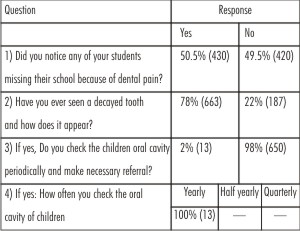 | Table III: Awareness on dental caries
 |
 | Table II:Exposure to dental health education
 |
 | Table IV: Experience and Knowledge on dental trauma
 |
(inclusion of dental health in their teaching curriculum, about their exposure to education camps and their usefulness), dimension III with 4 questions related to their awareness on dental caries (ability to detect decayed tooth, their awareness regarding students missing the school because dental decay and related pain and periodic observation and necessary referrals) and dimension IV with 7 questions related to their experience and knowledge on providing first-aid in case of dental trauma (experience of dental emergency and inclusion of first aid in their teaching curriculum).
Results and Discussion
The answers obtained as a result of distribution of the questionnaire are summarized in tables I, II, III, IV after categorizing the questions in to 4 dimensions as mentioned above in order to present the data in complete and easily understandable form.
The study design being cross sectional allowed the massive collection of information from many primary school teachers within limits of resources. A direct personal approach was used for this survey because of the inherent advantage of extremely good response rate. A self administered questionnaire was carefully constructed and organized based on questionnaire design updated by WHO to minimize information bias and was designed to obtain relevant back ground information in line with the objectives of the study.[9] School teachers have been considered potentially important primary agents of socialization, with the ability to influence the knowledge, attitudes and behaviour of school children. Thus in the present study an effort was made to assess the school teachers knowledge.
Knowledge about dentition in health and disease was measured from the responses to the 19 questions in the questionnaire. To make the study more purposeful and also to present the data in an organized and structured form the questionnaire was divided into four dimensions.
Dimension I: Comprised questions related school teacher's knowledge regarding dentition, the answers obtained were when summarized 78% of the school teachers know that the teeth eruption takes place two times in human life time; these results were in accordance with the study done by Chaudhary F et al.[10] Only 13% percent could answer correctly the age of onset of eruption of the permanent teeth as 6-7 yrs and these results were comparable to the study done by Subramaniam R et al,[11] and few studies conducted in Hong Kong[12] and England,[13] and in contrast with a study conducted in two south European countries (Porto and Istanbul).[14] Only3% of the study population considered the primary teeth as important as permanent teeth and rest of them does not give much importance to the primary dentition thinking that these teeth will be ultimately replaced by the permanent teeth. In this dimension it is not surprising to have answers of this sort, as it is a general observation to have 2 sets of dentition in humans and the important things are the age of eruption and giving importance to primary dentition, the knowledge regarding these aspects was relatively very much poor in the study population.
Dimension II: When the questions related to their exposure to dental health education were asked 73% recollected that their teaching curriculum included the education regarding the teeth and its importance for children. Regarding educating children on oral health care, only 27% of the teachers attempted to do so, which is in contrast to the project reports of oral health promotion and intervention activities in which 92% answered that they attempt to educate children about oral health.[15] 49%
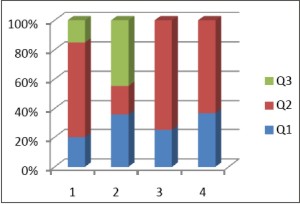 | Graph I: General Knowledge About Dentition
 |
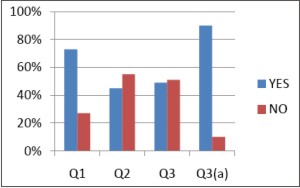 | Graph II Exposure To Dental Health Education
 |
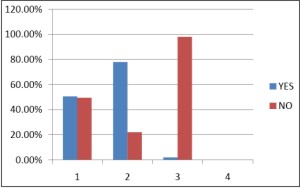 | Graph III: Awareness On Dental Caries
 |
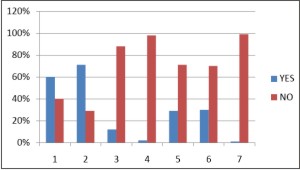 | Graph: IV Experience And Knowledge On Dental Trauma
 |
teachers have attended the dental camps at least once in their schools and 53% felt that the camps conducted were educative both for children and teachers. Though the teaching curriculum contain teaching dental health education to school children, many of them did not do that, the probable reason could be that, they themselves are unaware of the importance of teeth which indicates the need for upgrading their knowledge as well as making them to realise the importance of prevention.
Dimension III: Dental caries was chosen because it is the most common dental problem in children. When the questions related to caries were asked, 50.5% of the teachers noticed children missing the school because of dental decay and related pain indicating it's prevalence in the community. About 78 % of teachers know how a decayed tooth appears but a small proportion of the teachers check the oral cavity of the children yearly once and refer to the dentist. This dimension indicated the intensity of the problem prevailing in the community and measures should be taken by the concerned authorities to periodically examine the school children oral cavity and to make necessary referrals.
Dimension IV: Dental trauma being an emergency condition, 60% of the study subjects had experienced this sought of emergency in the school premises. These figures were in accordance with the study results of Subramaniam R et al[11] and Caglar et al.[14] Regarding teachers' training programme containing first-aid course, 71% of the teachers responded positively which is a promising finding. In similar studies conducted in Hong Kong,[14] United Kingdom[16] and Bangalore[17] the corresponding figures were 99.4%, 57.9% and 95% respectively. Very few respondents (12%) recollected that first aid course covered management of dental trauma indicates that the managing the dental injuries is not given much importance in the curriculum. When a question was asked on whether, they had attended any course on their own, only 2% answered indicating that majority of teachers do not try to upgrade their knowledge after their basic graduation. Only 29% of the teachers know that the broken piece of the tooth is useful which is in contrast with Mesgarzadeh et al[18] study in which more than 50% knows the same. When complete loss of the tooth occurs, only 30% of them know that it can be replanted out of which 99% of them does not know that it should be stored in proper medium and to be brought within half an hour to the dentist. Though the direct or indirect experience of dental trauma to the teachers is not an uncommon phenomenon they had little knowledge regarding its prevention and immediate management, and was in accordance with many studies.[18]-[21]
This particular survey was based on the concept of teachers' key role in education and motivation of school children on the importance of dental health and referral to a dental surgeon for timely intervention. These factors would bring awareness among school children regarding oral health which would further help in decreasing the prevalence of oro-dental problems. Thus, few recommendations can be considered to improve the knowledge level among school teachers.
1. The target group in the teacher's community of any particular school should be identified. An ideal target group would comprise of class teachers, teachers appointed for physical education, life sciences teachers and the principal as they directly come in contact with school children.
2. The teacher's effort should be recognized, appreciated and certified as oral health ambassadors, for the particular school where they are working.
3. Educational programmes, trainings in the form of mock drills and incorporation of emergency management of dental injuries in the curriculum of physical education teachers should be considered.
a. Educational programmes should include problems and consequences, availability of after hour emergency service, storage media for avulsed teeth, critical timing for reimplantation of avulsed teeth, current concepts of management of fractured teeth.
4. Dental and medical Institutional authorities in co-ordination with the school authorities should plan such educative programmes for teachers so that teachers can educate the children.
5. Periodically the teachers can inspect the oral cavity of the school children and should make the child and parent realize the problem existing in the oral cavity and consequences of not being treated.
6. Voluntary organizations along with dental educational institute authorities should take active participation in education regarding dental health issues to primary health providers (Anganwadi workers) and school teachers who are working in rural areas, where medical facilities are not readily available.
Conclusion
This survey was an effort to interact with the teachers so that the knowledge, attitude and practice of the teachers regarding dental issues can be identified. Hence, keeping this information as baseline data further educative and motivational programmes can be planned, developed and organized.
References
1. Mahmoud K, Ahed M, Khaled N. Oral health attitudes, knowledge and behaviour among school children. J Dent Education 2006; 70: 179-87.
2. Shodan M, Prasad KVV, Javali SB. School teacher's knowledge of oral disease prevention: A survey from Dharwad, India. Journal of Investigative and Clinical Dentistry 2012; 3: 62-7.
3. Khan N, Al-Zarea B, Al-Mansour M. Dental caries, hygiene, fluorosis and oral health knowledge of primary school teachers of Riyadh, Saudi Arabia. Saudi Dent J 2001; 13:128-32.
4. Mwangosi IEAT, Nyandindi U, Matee M. Participation of primary school teachers in oral health education in Rungwe district, Tanzania. East African Medical Journal 2001; 78:662-5.
5. Walla T, Tewari A, Chawla HS, Goyal A. Effect of training school teachers on KAP and dental caries of 7-9 year old school children. J Indian Soc Pedod Prev Dent 2000; 18: 47-53.
6. Nayandindi U, Milen A, Palin-Palokas T, Robison V. Impact of oral health education on primary schoolchildren before and after teachers' training in Tanzania. Health Promotion International 1996; 11: 193-201.
7. Simratvir M. A study to assess the role of teachers in the promotion of oral health in developing countries. J Educ Ethics Dent 2011; 1: 33-6.
8. Lang WP, Woolfolk MW, Faja BW. Oral health knowledge and attitudes of elementary school teachers in Michigan. J Public Health Dent 1989; 49: 44-50.
9. Nair R, Sann LM.Health research methodology: A guide for training in research methods. IInd Edition. WHO Regional office for the western pacific, Manila 2001.( ISBN929061157)
10. Chaudhary F, Khayyam KU, Siddiqui MJ, Anjum R, Muzammil S. Impact of teaching on dental knowledge in fifth standard of MCD primary school children of south Delhi. Journal of Applied Pharmaceutical Science 2011; 1: 91-3.
11. Subramaniam R, Mittal S, Hiregoudar M, Mohandas U, Sakeenabi B, Prasanth GM et al. Knowledge of upper primary and secondary school physical education instructors in Davangere city,India, about emergency management of dental trauma. J Educ Ethics Dent 2011;1: 18-23.
12. Chan AW, Wong TK, Cheung GS. Lay knowledge of physical education teachers about the emergency management of dental trauma in Hong Kong. Dent Traumatol 2001, 17:77-85.
13. Olivier L, Christoph G, Mohammed EM, Thomas VA. Impact of educational posters on the lay knowledge of school teachers regarding emergency management of dental injuries. Dent Traumatol 2009; 25: 406-12.
14. Caglar E, Ferreira LP, Kargul B. Dental trauma management knowledge among a group of teachers in two South European cities. Dent Traumatol 2005;21: 258-62.
15. Oral health promotion and intervention activities carried out in rural areas of Davangere district; A GOI-WHO collaborative programme 2006-2007.
16. Blakytny C, Surbuts C, Thomas A, Hunter ML. Avulsed permanent incisors: Knowledge and attitudes of primary school teachers with regard to emergency management. Int J Paediatr Dent 2011; 11: 327-32.
17. Mohandas U, Chandan GD. Knowledge, attitude and practice in emergency management of dental injury among physical education teachers: A survey in Bangalore urban schools. J Indian Soc Pedod Prev Dent 2009; 27:242-8.
18. Mesgarzadeh AH, Shahamfar M, Hefzollesan A. Evaluating knowledge and attitudes of elementary school teachers on emergency management of traumatic dental injuries: a study in an Iranian urban area. Oral Health Prev Dent. 2009; 7: 297-308.
19. Ramesh V. Avulsed permanent incisor: Knowledge and attitudes of school teachers towards early management of dental injuries among school children in Davangere. J of Ind Association of Pub Health Dentistry 2011; 18: 396-401.
20. Chandrasekhar BS, Vanishree N, Jayakumari HL, Mohan ANJ, Gupta N. Knowledge, attitudes and practices towards oral health among school teachers of Kanakapura taluk, Bengaluru Rural District. J of Ind Association of Pub Health Dentistry 2011; 18: 654-9.
21. Prasanna S, Giriraju A, Narayan NL: Knowledge and attitude of primary school teachers towards tooth avulsion and dental first aid in Davangere city: A cross sectional survey. International Journal of Clinical Pediatric Dentistry 2011; 4: 203-6. |